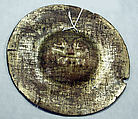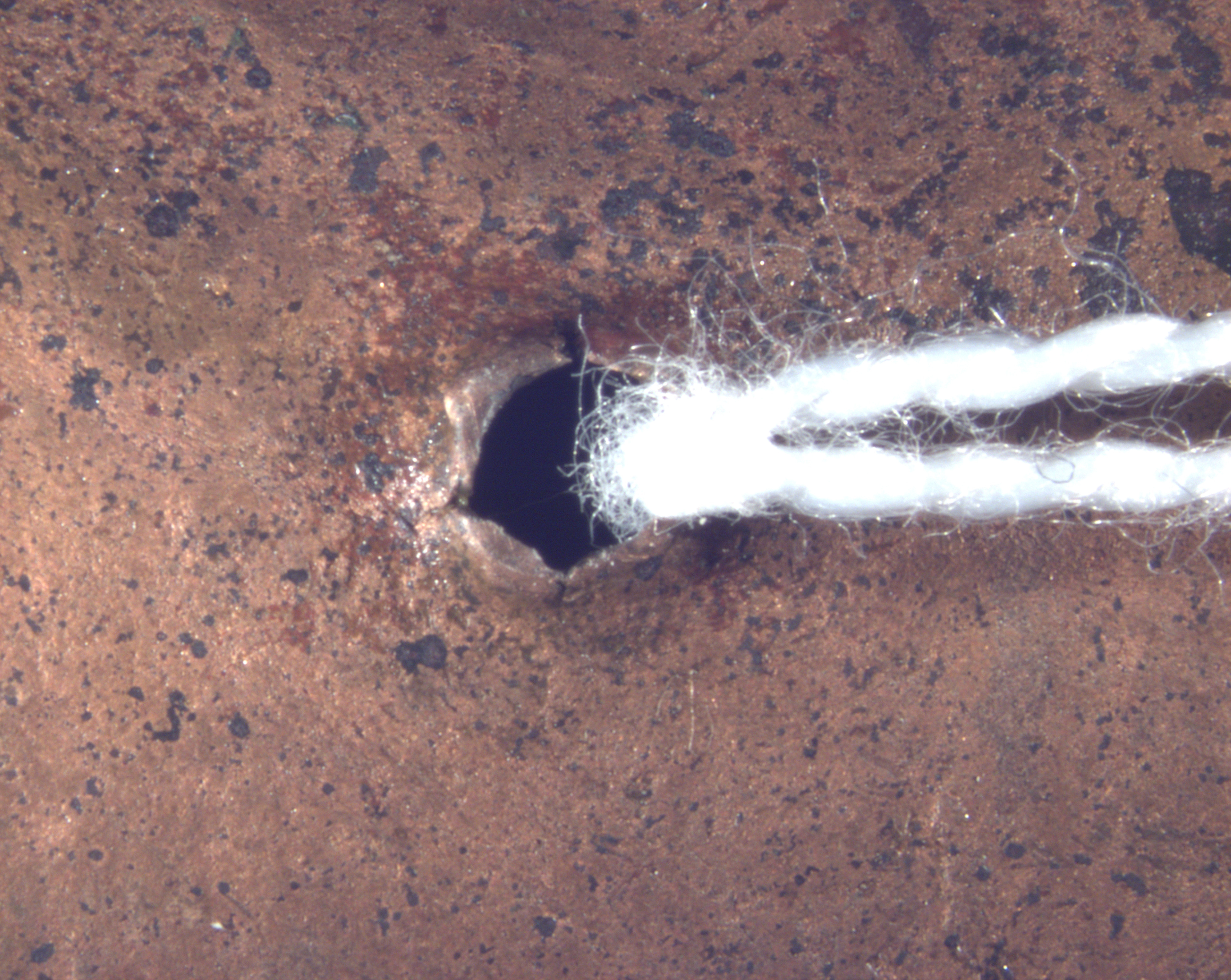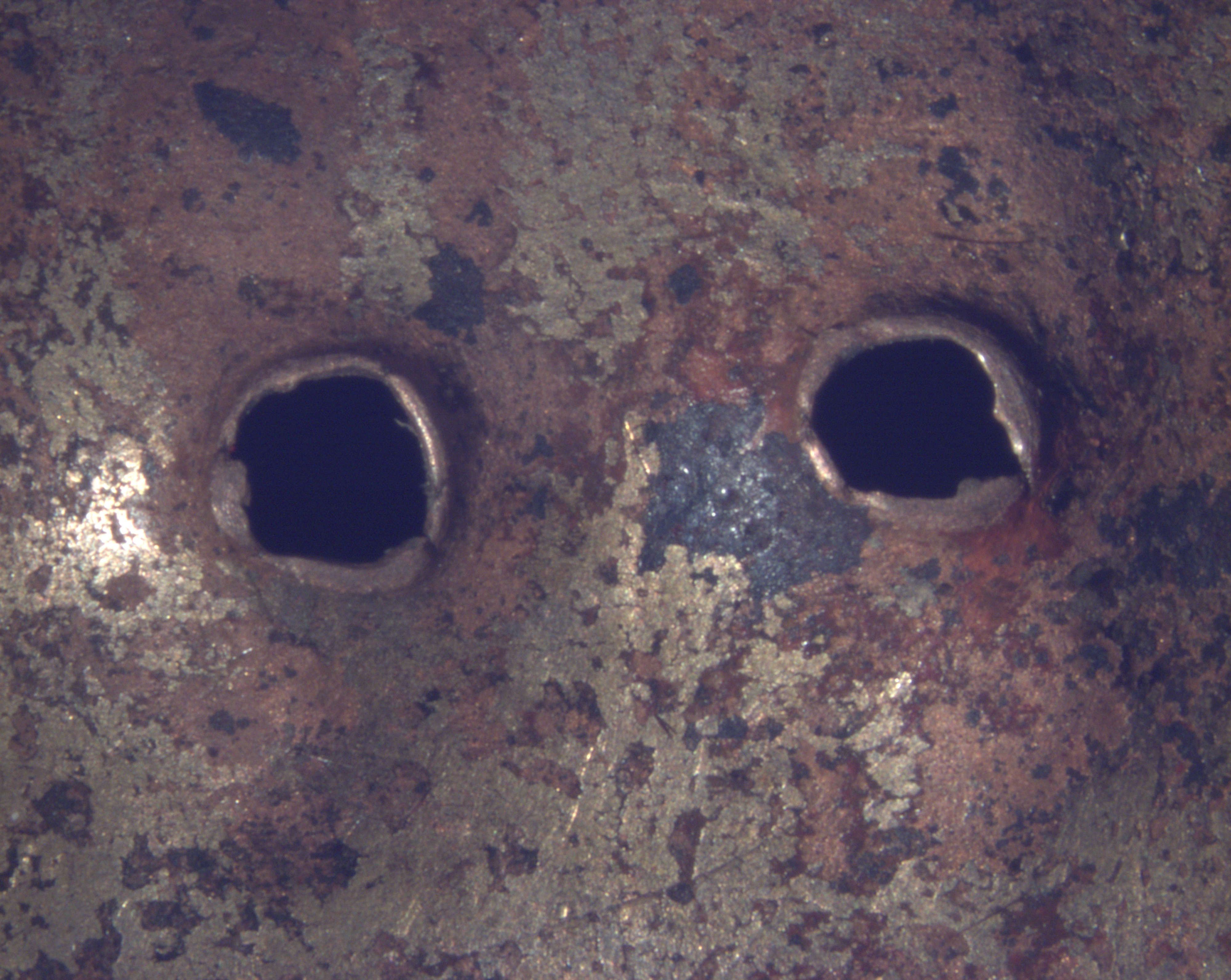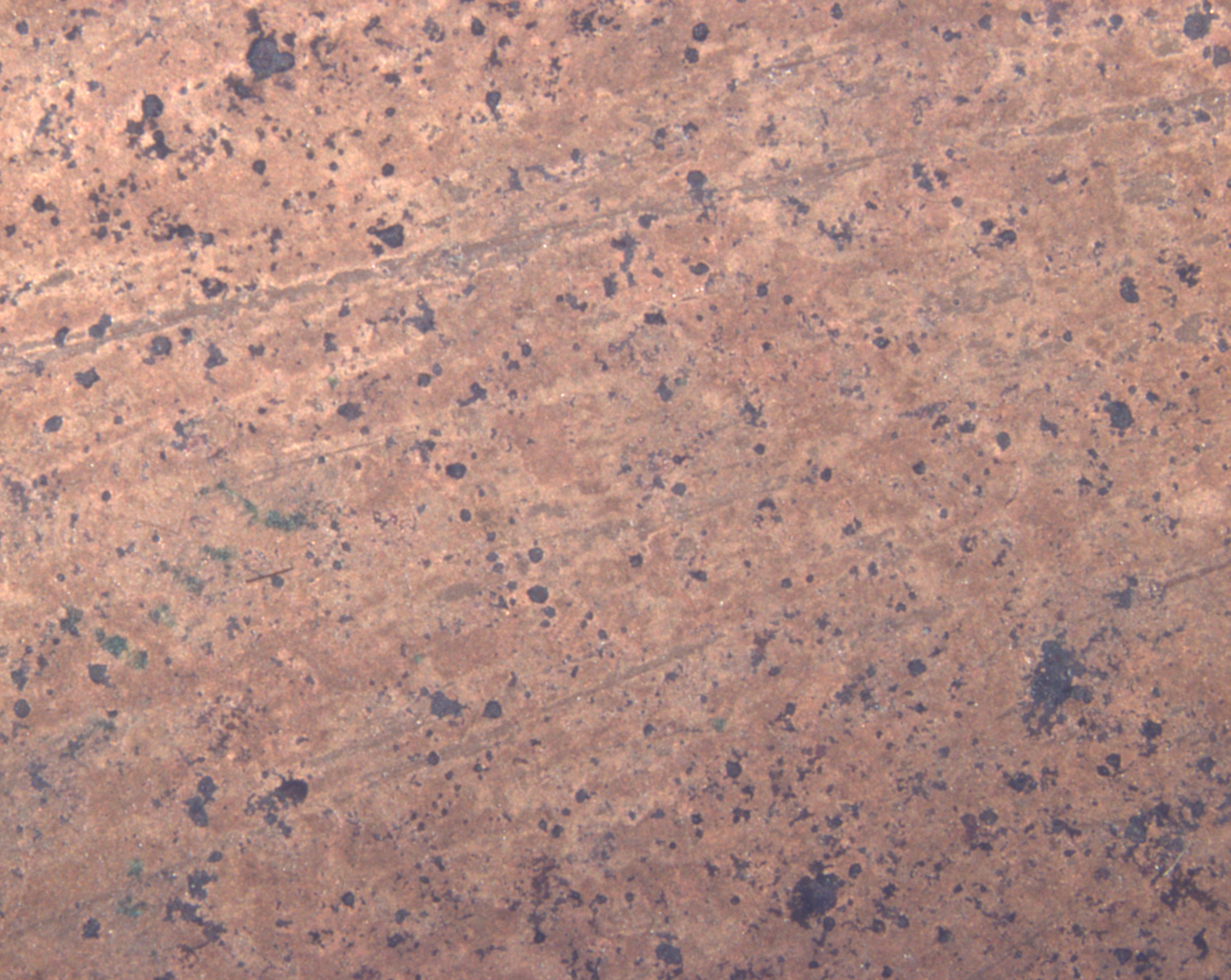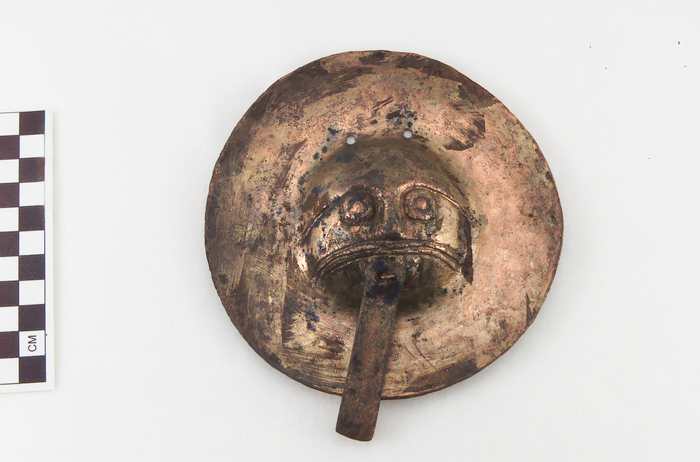Disk Ornament
Not on view
Technical note: Optical microscopy and XRF conducted in 2017.
This metal disk, possibly a pectoral, belongs to the corpus of artifacts often referred to as tincullpas described by Verneau and Rivet (1912, 299–306) and Jijón y Caamaño (1920). This disk shows a mammalian face in high relief at its center and flat undecorated edges around the outside. While these faces tend to be identified as feline (see Ugalde 2009), Rodríguez (1992, 82–83) has drawn attention to certain features as indicators of a kinkajou (Potos flavus). In this case, the face includes two semi-circular eyes, a nose whose bridge begins above the eyes, and a rectangular mouth with four teeth. The two central teeth have perforations, which may have secured a long movable tongue attached with staples (cf. Jijón y Caamaño 1920, pl. 6, no. 5). There are two more holes, perhaps for suspension near the top of the disk.
The disk was made from hammered sheet, worked by repoussé and then gilded on the obverse. The sheet is work-hardened by repeated cycles of hammering and annealing. To create the present disk, metalsmiths hammered sheet to the current thickness of the disk. To form the central design of the mammal’s head, the smith may have rested the disk on a rigid form and worked the sheet from the reverse side to sink the central hemispherical shape. The details of the face were created with repoussé accomplished with a metal or bone punch. After completing the repoussé design, the smith undertook perforating the disk. They perforated the two top holes from the obverse (see image 2), while they perforated the two holes in the mammal’s teeth from the reverse (see image 3).
The gilding was applied only to the obverse side of this disk probably by a method known as fusion or wash gilding. The edges and the reverse surface were left ungilded. This technique, characteristic of gold work found in Ecuador and Southern Colombia in the Nariño region, has also been found occasionally in northern Peru (see Scott 2011). A layer of molten gold-copper alloy was applied on the surface and then re-heated to a high temperature, followed by depletion gilding to remove copper from the surface and hammering to create smoothness.
At present, the gilding layer is spotty and incomplete, having been altered during burial by corrosion of the copper and subsequent cleaning to remove it. This occurred in conjunction with a textile that had been wrapped around the disk during burial, leaving the textile’s weave pattern visible in the remaining gilding (see image 4).
An early investigation (Jijón y Caamaño 1920) reported finds of these particular disks from the site of Alchipichí, where 36 were found in a single vessel in a tomb. Over time, it has become clear that the disks were deposited—and depicted in other media—over a wider geography, mainly associated with the Manteño Huancavilca tradition (A.D. 600-1533) (Gutiérrez 2002, 2011; Lleras 2015). The disks deposited in the Alchipichí tomb may have been imported from coastal sites (personal communication, María del Carmen Molestina, 2017). Some published examples of these disks (Verneau and Rivet 1912, pl. 24, no. 16; Jijón y Caamaño 1920, pls. 1, 2) are quite similar to the present disk for their general design and specifically for their D-shaped eyes. The latter study included compositional analysis, through precipitation reactions, that showed the pectorals to be predominantly copper with trace amounts of iron and lead. One of several such pectorals in the collections of the Ministerio de Cultura (Quito), 21.4 cm in diameter, shows a similar design to the present disk, but features circular eyes and appears to lack perforations (Lleras 2015).[1] Other analogous disks are in the collections of the National Museum of the American Indian and were recovered from a range of coastal and inland contexts (01/0607 from Manabí; 01/5693 from Esmeraldas; 21/4489 from Chimborazo). One from Hacienda Carbón, Tungurahu (NMAI 19/4865) (see image 6) along with one from Pomasqui, near Quito (Jijón y Caamaño 1920, pl. 6, no. 5) show a separate strip of metal that is attached to the disk through the perforations in the mouth that are a common feature of this corpus. The strip in each case extends partially beyond the edge of the pectoral. In the former case, a staple runs through the perforations in the mouth and those in the separate strip, securing the pieces to one another. The strip represents the tongue of the mammal. With the disk attached to a person’s chest, the tongue would have moved when the person moved, or when there was wind, striking the disk and producing a sound.
Notably there are depictions of these disks, with mammal or feline faces, in other media, such as on Jama Coaque ceramic figures depicting shamans, dancers, and a warrior according to Gutiérrez (2011, 150–51) and on a stone seat from Cerro Jaboncillo (Saville 1907–10, pl. XXVII, no. 1). The Jama Coaque metal pectorals (e.g., Gutiérrez 2011, fig. 50b,c,d), along with one in the Dallas Museum of Art (1983.6.FA), while showing a mammal face at their center, and having been fabricated through hammering and repoussé, are quite distinct from the present disk, the disk from Riobamba shown in Verneau and Rivet (1912, pl. 24, no. 16), and numerous examples from Alchipichí and Pomasqui shown in Jijón y Caamaño (1920). The distinction is clearest in the fact that the former are decorated around their borders, filling up the space around the mammal’s head, and their repoussé work is far more rounded. Indeed, the mammal’s eyes of the former group are circular with those of the latter are usually closed semi-circles. Another disk, without perforations, and ascribed to the Manteño tradition, shows an embossed mammal head (with circular eyes), but is much smaller (about 3 cm in diameter), has no perforations, and lacks decoration around the mammal face (Centro Cultural Libertador Simón Bolívar (Guayaquil) (CCLSB) GA-1-2827-85).[2]
The name tincullpa may be an alteration of tincurpa, which was recorded by the Spanish missionary Pablo José Arriaga (1621) in Peru for metal plates or clasps; it is a Quechua term and also has been applied to describe ear pendants that look similar to the pectorals. While there is early evidence for the use, but not production, of metal on the Ecuadorian coast at sites like Salango (ca. 1500 B.C.) (Hosler 1994, 106), much of the Manteño Huancavilca metalworking tradition—in which hammering, chiseling, embossing, and the production of gilded copper are common—has been defined through the excavation of metal objects from the Ayalán cemetery whose dates, through radiocarbon analysis, extend from A.D. 700 to A.D. 1700 (Lleras 2015; Ubelaker 1981). Copper sources only exist in the inland Sierra, while people in more coastal regions may have acquired gold, which is also found in the Sierra, from alluvial deposits that formed in rivers emanating from the Sierra (Lleras 2015). At present, the Huancavilca community or pueblo consists, according to the Consejo de Desarrollo de las Nacionalidades y Pueblos del Ecuador, of 100,000 persons living in the Santa Elena Peninsula. For more information on the Huancavilca community, its history and present, please see Álvarez 1999.
Bryan Cockrell, Curatorial Fellow, Arts of Africa, Oceania and the Americas, 2017
Beth Edelstein, Associate Conservator, Objects Conservation
Ellen Howe, Conservator Emerita, Objects Conservation
Caitlin Mahony, Assistant Conservator, Objects Conservation
[1] The Ministerio de Cultura currently holds the collections of the Museo Nacional de Quito.
[2] The CCLSB is the former Museo Antropológico y de Arte Contemporáneo.
Related objects: 1979.206.510, 1987.394.232, 1980.83.15, 1987.394.233, 1995.427
References
Álvarez, Silvia. De Huancavilcas a comuneros: Relaciones interétnicas en la Península de Santa Elena, Ecuador. Quito: Abya Yala, 1999.
Gutiérrez Usilos, Andrés. Dioses, símbolos y alimentación en los Andes. Quito: Abya Yala, 2002.
-----. El eje del universo: Chamanes, sacerdotes y religiosidad en la cultura Jama Coaque del Ecuador Prehispánico. Madrid: Ministerio de Cultura, 2011.
Hosler, Dorothy. The Sounds and Colors of Power. Cambridge: MIT Press, 1994.
Jijón y Caamaño, Jacinto. "Los tincullpas y notas acerca de la metalurgia de los aborígenes del Ecuador." Boletín de la Sociedad Ecuatoriana 1, no. 1 (1920): 4-43.
Lleras Pérez, Roberto. Metallurgy in Ancient Ecuador. Oxford: Archaeopress, 2015.
Rodríguez Bastidas, Edgar Emilio. Fauna precolombina de Nariño. Santafé de Bogotá: Fundación de Investigaciones Arqueológicas Nacionales (Banco de la República), Instituto Colombiano de Antropología, 1992.
Saville, Marshall Howard. The Antiquities of Manabi, Ecuador. New York, Irving Press, 1907-1910.
Scott, David A. "The La Tolita-Tumaco Culture: Master Metalsmiths in Gold and Platinum." Latin American Antiquity 22, no. 1 (2011): 65-95.
Ubelaker, Douglas H. The Ayalán Cemetery: A Late Integration Period Burial Site on the South Coast of Ecuador. Washington, D.C.: Smithsonian Institution, 1981.
Ugalde, María Fernanda. Iconografía de la cultura Tolita: Lecturas del discurso ideológico en las representaciones figurativas del Desarrollo Regional. Wiesbaden: Reichert, 2009.
Verneau, René and Paul Rivet. Ethnographie ancienne de l’Equateur. Paris: Gauthier-Villars, 1912.
Due to rights restrictions, this image cannot be enlarged, viewed at full screen, or downloaded.
This artwork is meant to be viewed from right to left. Scroll left to view more.
